What is an Insuring Agreement?
An insuring agreement is the part of an insurance contract in which the insurance company explains exactly which risks it will give insurance coverage for in exchange for premium payments at a certain amount and interval. The insuring agreement also generally lists the exclusions for insurance coverage so that the policyholder knows the specific extent of their coverage. Insuring agreements are necessary in case a conflict arises over whether or not a specific loss is covered. Both the insurance company and the policyholder should be able to determine from the insuring agreement whether a loss is covered. Although insuring agreements are designed to clear up these problems, disagreements still appear about the terms of the insuring agreement. These often result in lawsuits in which each party puts forward competing interpretations of the insuring agreement.
An Insuring Agreement has the following parts in it generally:
Declaration – is a term applied to underwrite information identifying the insurer and insured, subject matter, premium or how the premium will be determined, policy limits, policy term, and a list of forms that make up the body of the contract. In some policies, the perils will be listed in the declaration, but in most policies, other than the standard fire policy, the perils are listed in the body of the contract. The declaration normally appears on the first page of the contract.
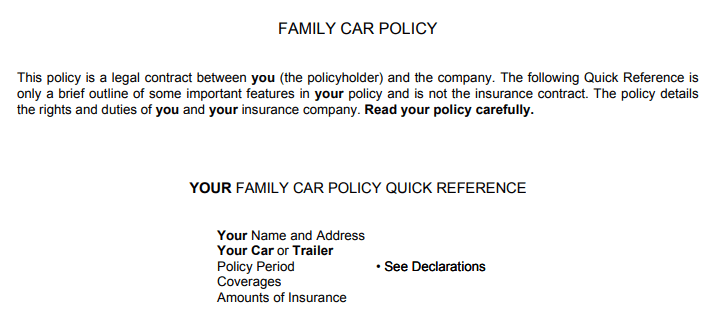
Above is the first part ie. declaration part of an auto insurance policy’s Insuring Agreement in which the name of the insured, vehicle make and model, policy start and end dates, amount of insurance, etc are mentioned.
Insuring Agreement – states what it is that the insurer agrees to cover under the terms of the contract. It will refer to the subject matter of the insurance. In the standard fire policy, the declaration and the insuring agreement will appear together on the first page of the contract. In those policies that have more than one subject matter, such as auto insurance policies, there is an insuring agreement for each subject matter.
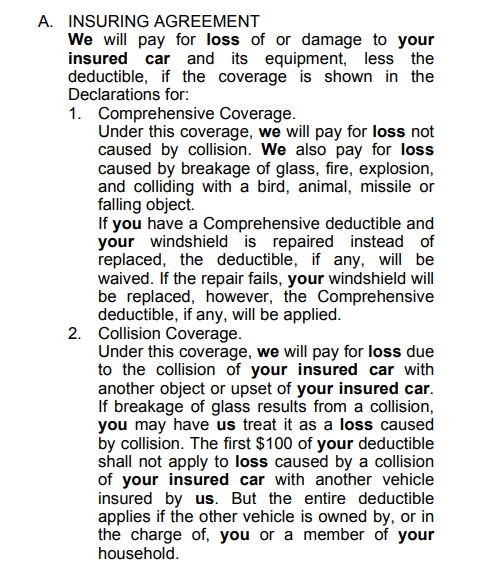
This is the Insuring Agreement part of an auto insurance policy which consists of Insuring Agreement for car damage coverages. An auto insurance policy usually has 2 subject matters namely “Liability Coverage” and “Car Damage Coverages”.
Exclusions – These provisions in policy will fix the limits on the promises of coverage stated in the insuring agreements. These provisions serve one or more purposes, including elimination for coverage of (1) coverage for losses caused by certain perils, (2) coverage provided by other insurance, (3) coverage of uninsurable losses. Basically, exclusions are those portions of the insurance contract which limit the scope of the coverage and/or list the causes and conditions which are not covered. Following is an example of common exclusions in an auto insurance policy –
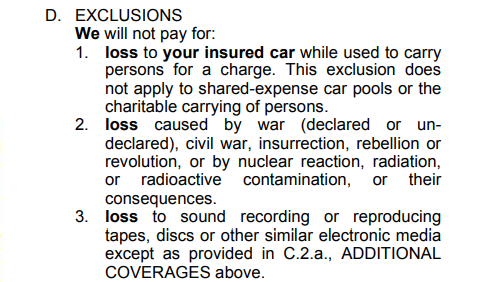
Conditions – Those provisions in a policy which call for the insured to do something, or not to do something, either before or after a loss has occurred. The insurer’s obligation to pay for losses or to provide services is based on the insured’s obligation to perform certain duties or prevent certain things from happening. One of the duties of the insured, before a loss, is to have been truthful in applying for the insurance coverage. Concealment or fraud by the insured will make the policy void. One of the duties of the insured, after a loss, is to protect the property from further loss. Failure to do so could relieve the insurer of the obligation to pay the claim.
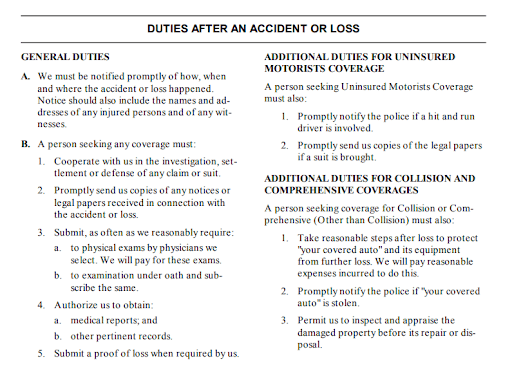
Above is an example of conditions present in an auto insurance policy’s Insuring Agreement. The insurer has mentioned about the duties of the insured in case of an accident or loss.
Miscellaneous Provisions – Those provisions which, along with the declaration, insuring agreement, exclusions, and conditions complete the insurance policy. These provisions help to establish working procedures for carrying out the terms of an insurance policy. Following is an example of such provisions mentioned in case of an auto insurance policy –
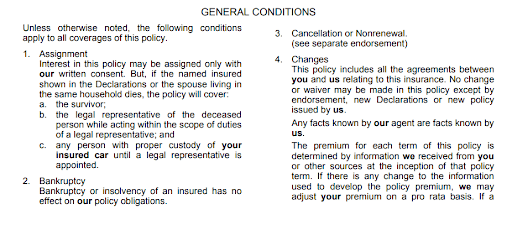







Leave A Comment